Spatiotemporal Coupling Analysis of Street Vitality and Built Environment: A Multisource Data-Driven Dynamic Assessment Model
Abstract
1. Introduction
- An Enhanced Detection Model: We introduce an improved YOLOv11-based pedestrian detection model. Its architectural innovations include a novel dual-backbone network for enhanced multi-scale feature fusion, the integration of a SPDConv module to enrich feature representation in complex scenes, and a DySample mechanism within the detection head to improve robustness against severe occlusions.
- A Multi-Source Data Fusion Framework: We develop a novel spatiotemporal coupling framework that dynamically integrates the detection results from street view imagery with multi-source geographic data, including Baidu heatmaps, road networks, and POI (Point of Interest) information. This enables a quantitative and dynamic assessment of the interplay between built environment factors and street vitality.
- Empirical Validation and Insights: The proposed model and framework are rigorously validated through a case study in Yibin City, China. The model achieves state-of-the-art performance, and the analysis provides actionable insights into the spatial distribution of street vitality and its drivers, offering a scientific basis for targeted urban management and planning strategies.
2. Study Area and Data Sources
2.1. Study Area
2.2. Data Sources
2.2.1. Road Network Data
2.2.2. Baidu Heatmap Data
2.2.3. Amap POI Data
2.2.4. Street View Data
3. Methodology
3.1. Research Framework
3.2. Improved YOLOv11 Pedestrian Detection Model
- To address the significant scale variation of pedestrians in street scenes, a two-backbone architecture is proposed, as illustrated in Figure 6. The shallow branch employs a C3k2 module to capture fine-grained features such as pedestrian contours and poses, while the deep branch incorporates a CBFuse module to integrate multi-scale feature representations. Within this framework, the CBLinear module performs channel binding, and the CBFuse module utilizes nearest-neighbor interpolation for feature alignment and weighted fusion. The architecture retains two critical feature scales—1/8 and 1/16—ensures compatibility with pre-trained weights via a Silence module, and enhances feature representation through the incorporation of a C2PSA attention mechanism. This design preserves the computational efficiency of the original YOLOv11 while improving detection performance in occluded and high-density crowd scenarios through its dual-branch CBLinear–CBFuse structure. The experimental results demonstrate a 5.1% improvement in mAP50 compared to the single-backbone configuration.
- To address the challenges of dynamic occlusion and complex backgrounds in street scene detection, this study incorporates a SPDConv module into the YOLOv11 architecture [29], as illustrated in Figure 7. This module employs spatial restructuring of feature maps to reduce resolution while preserving informational integrity and utilizes parallel dilated convolutions with multiple dilation rates to capture multi-scale contextual features. By integrating a channel attention mechanism, it achieves adaptive fusion of local texture details and global semantic information. This design significantly enhances pedestrian detection accuracy in complex environments without compromising real-time performance, thereby offering a reliable quantitative evaluation tool for urban dynamic monitoring.
- To mitigate performance degradation in pedestrian detection caused by severe occlusion in high-density urban street scenarios, a DySample [30] is incorporated into the detection head of YOLOv11, as depicted in Figure 8. In contrast to conventional dynamic convolution methods (e.g., CARAFE, FADE), which rely on dynamic kernels to generate sub-networks, DySample operates through a point-based sampling strategy. Its core mechanism involves decomposing a single point in the input feature map into multiple sampling points. Initially, sampling positions are separated via bilinear initialization. Content-aware offsets are then generated to reconstruct the sampling grid, and standard bilinear interpolation is applied for feature resampling. The dynamic behavior arises from the input-dependent prediction of sampling offsets, eliminating the need for dynamic convolution kernels and requiring only a lightweight coordinate offset prediction module. Sparsity is achieved by locally constraining the offset range, which prevents boundary artifacts caused by overlapping sampling points and effectively mitigates feature loss due to motion blur and occlusion. This lightweight architecture offers a practical solution for continuous street vitality monitoring in complex urban environments.
3.3. Construction of a Built Environment Indicator System
- Quantification Method for External Representation of Vitality
- Instantaneous vitality intensity provides a dynamic characterization of street space vitality from the perspective of temporal slices. It refers to the relative density of people present in a street space at a given moment, denoted as Vi.
- The average vitality intensity represents the average level of street space vitality over a 24 h period. The calculation formula is as follows:In the formula, denotes the average vitality intensity value of the street; i represents different time intervals within a given day, where ; and n indicates the number of time intervals included in the calculation.
- Quantification Method for Intrinsic Composition of VitalityIntrinsic composition indicators describe the physical and socio-economic attributes of the street itself. Specific definitions are provided in Table 2.
3.4. Standardization Framework for Multi-Source Heterogeneous Data and Spatiotemporal Coupling Modeling
3.4.1. Data Preprocessing and Standardization
3.4.2. Core Algorithms and Spatial Analysis Models
- Spatial Principal Component AnalysisTo reduce multicollinearity among indicators and objectively determine their weights, principal component analysis (PCA) was performed on the standardized multi-dimensional spatial data matrix [34]. Through linear transformation, the original correlated variables are converted into a set of uncorrelated principal components, each being a linear combination of the original variables:In the formula, denotes the weight of the j-th indicator in the k-th principal component, and represents the score of the k-th principal component.
- Comprehensive Environmental ScoreThis metric is used to represent the holistic performance of each spatial unit across multiple environmental factors.In the formula, denotes the principal component weight.
- Coordination DegreeThis metric is used to quantify the balance of development among various environmental elements within the system. A higher coordination degree indicates more synchronized development of the elements and less spatial fluctuation. Its calculation is based on the dispersion degree between the scores of each principal component and their average score:In the formula, denotes the coordination degree of the i-th spatial unit, represents the score value of the k-th principal component for the i-th spatial unit, and signifies the mean value of the m principal component scores within the i-th spatial unit.
3.4.3. Spatial Output and Result Presentation
- On the ArcGIS platform, the Jenks Natural Breaks method was employed to classify the comprehensive score (T) and the coordination degree (C). This classification method determines intervals based on the inherent statistical distribution characteristics of the data, aiming to maximize differences between classes while minimizing variances within each class. Consequently, the generated visual products, such as spatial distribution maps and spatiotemporal change sequence diagrams, can most intuitively reveal the underlying patterns of the urban spatial structure. The specific spatial distribution results of the coupling analysis are detailed in Table 3.
- Principal component analysis was conducted on the standardized street vitality and environmental indicators using SPSS software (SPSS Statistics 27.0.1). Based on the rotated component matrix, the weights of the main factors were obtained, and then the comprehensive score of each street was calculated, as shown in Table 4.
4. Results and Analysis
4.1. Model Performance Evaluation
4.1.1. Ablation Experiment
4.1.2. Comparative Experiment
4.2. Spatial Distribution of Street Vitality
4.3. Results of the Spatiotemporal Coupling Model
5. Conclusions
Author Contributions
Funding
Institutional Review Board Statement
Informed Consent Statement
Data Availability Statement
Acknowledgments
Conflicts of Interest
References
- Ji, D.; Tian, J.; Zhang, J.; Zeng, J.; Namaiti, A. Identification and Spatiotemporal Evolution Analysis of the Urban–Rural Fringe in Polycentric Cities Based on K-Means Clustering and Multi-Source Data: A Case Study of Chengdu City. Land 2024, 13, 1727. [Google Scholar] [CrossRef]
- Xia, C.; Zhang, A.; Yeh, A.G. The varying relationships between multidimensional urban form and urban vitality in Chinese megacities: Insights from a comparative analysis. Ann. Am. Assoc. Geogr. 2022, 112, 141–166. [Google Scholar] [CrossRef]
- Chen, H.; Ge, J.; He, W. Quantifying Urban Vitality in Guangzhou Through Multi-Source Data: A Comprehensive Analysis of Land Use Change, Streetscape Elements, POI Distribution, and Smartphone-GPS Data. Land 2025, 14, 1309. [Google Scholar] [CrossRef]
- Choi, M.J.; Kim, Y.-j. Planning paradigm shift in the era of transition from urban development to management: The case of Korea. In Urban Planning Education: Beginnings, Global Movement and Future Prospects; Springer: Berlin/Heidelberg, Germany, 2017; pp. 161–174. [Google Scholar]
- Zhan, D.; Kwan, M.P.; Zhang, W.; Fan, J.; Yu, J.; Dang, Y. Assessment and determinants of satisfaction with urban livability in China. Cities 2018, 79, 92–101. [Google Scholar] [CrossRef]
- Wei, H.; Li, L.; Nian, M. China’s urbanization strategy and policy during the 14th five-year plan period. Chin. J. Urban Environ. Stud. 2021, 9, 2150002. [Google Scholar] [CrossRef]
- Li, P.; Xu, Y.; Liu, Z.; Jiang, H.; Liu, A. Evaluation and Optimization of Urban Street Spatial Quality Based on Street View Images and Machine Learning: A Case Study of the Jinan Old City. Buildings 2025, 15, 1408. [Google Scholar] [CrossRef]
- Zarin, S.Z.; Niroomand, M.; Heidari, A.A. Physical and social aspects of vitality case study: Traditional street and modern street in Tehran. Procedia-Soc. Behav. Sci. 2015, 170, 659–668. [Google Scholar] [CrossRef]
- Kang, N.; Liu, C. Towards landscape visual quality evaluation: Methodologies, technologies, and recommendations. Ecol. Indic. 2022, 142, 109174. [Google Scholar] [CrossRef]
- Milias, V.; Sharifi Noorian, S.; Bozzon, A.; Psyllidis, A. Is it safe to be attractive? Disentangling the influence of streetscape features on the perceived safety and attractiveness of city streets. AGILE GIScience Ser. 2023, 4, 8. [Google Scholar] [CrossRef]
- Chen, X.; Zhang, L.; Zhao, Z.; Zhang, F.; Liu, S.; Long, Y. Characterizing and Measuring the Environmental Amenities of Urban Recreation Leisure Regions Based on Image and Text Fusion Perception: A Case Study of Nanjing, China. Land 2023, 12, 1998. [Google Scholar] [CrossRef]
- Liang, H.; Zhang, J.; Li, Y.; Zhu, Z.; Wang, B. Automatic estimation for visual quality changes of street space via street-view images and multimodal large language models. IEEE Access 2023, 12, 87713–87727. [Google Scholar] [CrossRef]
- Jin, A.; Ge, Y.; Zhang, S. Spatial characteristics of multidimensional urban vitality and its impact mechanisms by the built environment. Land 2024, 13, 991. [Google Scholar] [CrossRef]
- Li, X.; Kozlowski, M.; Salih, S.A.; Ismail, S.B. Evaluating the vitality of urban public spaces: Perspectives on crowd activity and built environment. Archnet-IJAR Int. J. Archit. Res. 2024, 19, 562–583. [Google Scholar] [CrossRef]
- Liu, W.; Yang, Z.; Gui, C.; Li, G.; Xu, H. Investigating the Nonlinear Relationship Between the Built Environment and Urban Vitality Based on Multi-Source Data and Interpretable Machine Learning. Buildings 2025, 15, 1414. [Google Scholar] [CrossRef]
- Xie, Y.; Zhang, J.; Li, Y.; Zhu, Z.; Deng, J.; Li, Z. Integrating multi-source urban data with interpretable machine learning for uncovering the multidimensional drivers of urban vitality. Land 2024, 13, 2028. [Google Scholar] [CrossRef]
- Ma, Z. Deep exploration of street view features for identifying urban vitality: A case study of Qingdao city. Int. J. Appl. Earth Obs. Geoinf. 2023, 123, 103476. [Google Scholar] [CrossRef]
- Guo, X.; Chen, H.; Yang, X. An evaluation of street dynamic vitality and its influential factors based on multi-source big data. ISPRS Int. J. Geo-Inf. 2021, 10, 143. [Google Scholar] [CrossRef]
- Liu, S.; Zhang, L.; Long, Y.; Long, Y.; Xu, M. A new urban vitality analysis and evaluation framework based on human activity modeling using multi-source big data. ISPRS Int. J. Geo-Inf. 2020, 9, 617. [Google Scholar] [CrossRef]
- Li, Q.; Cui, C.; Liu, F.; Wu, Q.; Run, Y.; Han, Z. Multidimensional urban vitality on streets: Spatial patterns and influence factor identification using multisource urban data. ISPRS Int. J. Geo-Inf. 2021, 11, 2. [Google Scholar] [CrossRef]
- Nikpour, A.; Yarahmadi, M. Recognizing the components of street vitality as promoting the quality of social life in small urban spaces Case study: Chamran Street, Shiraz. Sustain. City 2020, 3, 41–54. [Google Scholar]
- Wu, W.; Niu, X. Influence of built environment on urban vitality: Case study of Shanghai using mobile phone location data. J. Urban Plan. Dev. 2019, 145, 04019007. [Google Scholar] [CrossRef]
- Wu, W.; Niu, X.; Li, M. Influence of built environment on street vitality: A case study of West Nanjing Road in Shanghai based on mobile location data. Sustainability 2021, 13, 1840. [Google Scholar] [CrossRef]
- Wangbao, L. Spatial impact of the built environment on street vitality: A case study of the Tianhe District, Guangzhou. Front. Environ. Sci. 2022, 10, 966562. [Google Scholar] [CrossRef]
- Yu, B.; Sun, J.; Wang, Z.; Jin, S. Influencing factors of street vitality in historic districts based on multisource data: Evidence from China. ISPRS Int. J. Geo-Inf. 2024, 13, 277. [Google Scholar] [CrossRef]
- Li, Y.; Yabuki, N.; Fukuda, T. Exploring the association between street built environment and street vitality using deep learning methods. Sustain. Cities Soc. 2022, 79, 103656. [Google Scholar] [CrossRef]
- Chen, L.; Jiang, X.; Tan, L.; Chen, C.; Yang, S.; You, W. Analysis of Spatial Vitality Characteristics and Influencing Factors of Old Neighborhoods: A Case Study of Ya’an Xicheng Neighborhood. Buildings 2024, 14, 3348. [Google Scholar] [CrossRef]
- He, L.-h.; Zhou, Y.-z.; Liu, L.; Cao, W.; Ma, J.-h. Research on object detection and recognition in remote sensing images based on YOLOv11. Sci. Rep. 2025, 15, 14032. [Google Scholar] [CrossRef] [PubMed]
- Yang, Z.; Wu, Q.; Zhang, F.; Zhang, X.; Chen, X.; Gao, Y. A new semantic segmentation method for remote sensing images integrating coordinate attention and SPD-Conv. Symmetry 2023, 15, 1037. [Google Scholar] [CrossRef]
- Xi, Y.; Qu, D.; Du, L. DDM-YOLOv8s for Small Object Detection in Remote Sensing Images. In Proceedings of the 2024 7th International Conference on Machine Learning and Natural Language Processing (MLNLP), Chengdu, China, 18–20 October 2024; IEEE: New York, NY, USA, 2024; pp. 1–7. [Google Scholar]
- Xia, C.; Yeh, A.G.O.; Zhang, A. Analyzing spatial relationships between urban land use intensity and urban vitality at street block level: A case study of five Chinese megacities. Landsc. Urban Plan. 2020, 193, 103669. [Google Scholar] [CrossRef]
- Hua, C.; Lv, W. Optimizing Semantic Segmentation of Street Views with SP-UNet for Comprehensive Street Quality Evaluation. Sustainability 2025, 17, 1209. [Google Scholar] [CrossRef]
- Li, Z.; Zhao, G. Revealing the spatio-temporal heterogeneity of the association between the built environment and urban vitality in Shenzhen. ISPRS Int. J. Geo-Inf. 2023, 12, 433. [Google Scholar] [CrossRef]
- Jiang, Y.; Han, Y.; Liu, M.; Ye, Y. Street vitality and built environment features: A data-informed approach from fourteen Chinese cities. Sustain. Cities Soc. 2022, 79, 103724. [Google Scholar] [CrossRef]
- Zhang, R.; Lu, Y.; Song, Z. YOLO sparse training and model pruning for street view house numbers recognition. Proc. J. Phys. Conf. Ser. 2023, 2646, 012025. [Google Scholar] [CrossRef]
- Tan, Y.; Song, J.; Bai, Y. Exploring the relationship between built environment and multidimensional street market vitality: Insights from urban villages in Shenzhen using multi-source data. PLoS ONE 2025, 20, e0332905. [Google Scholar] [CrossRef] [PubMed]
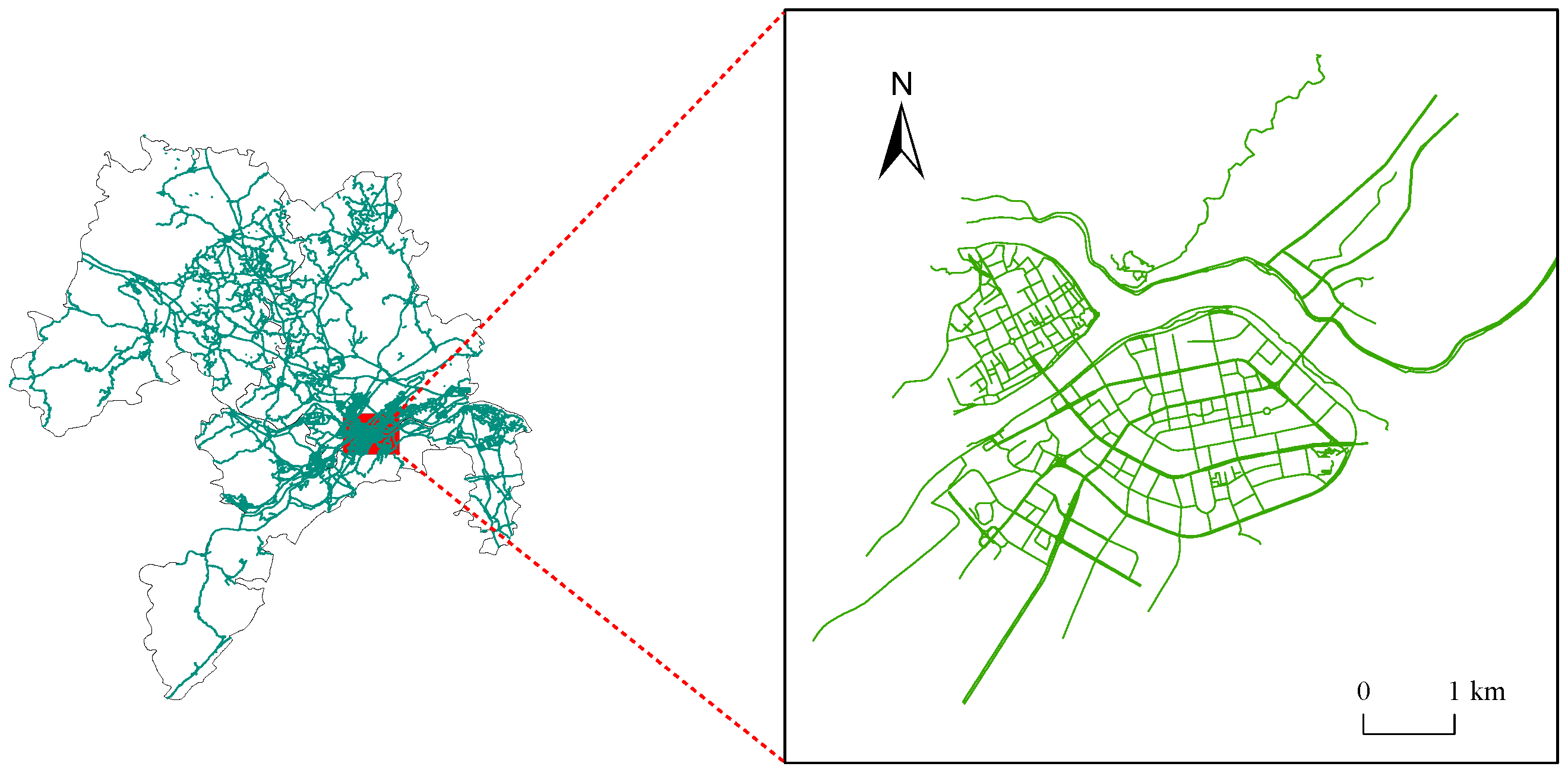
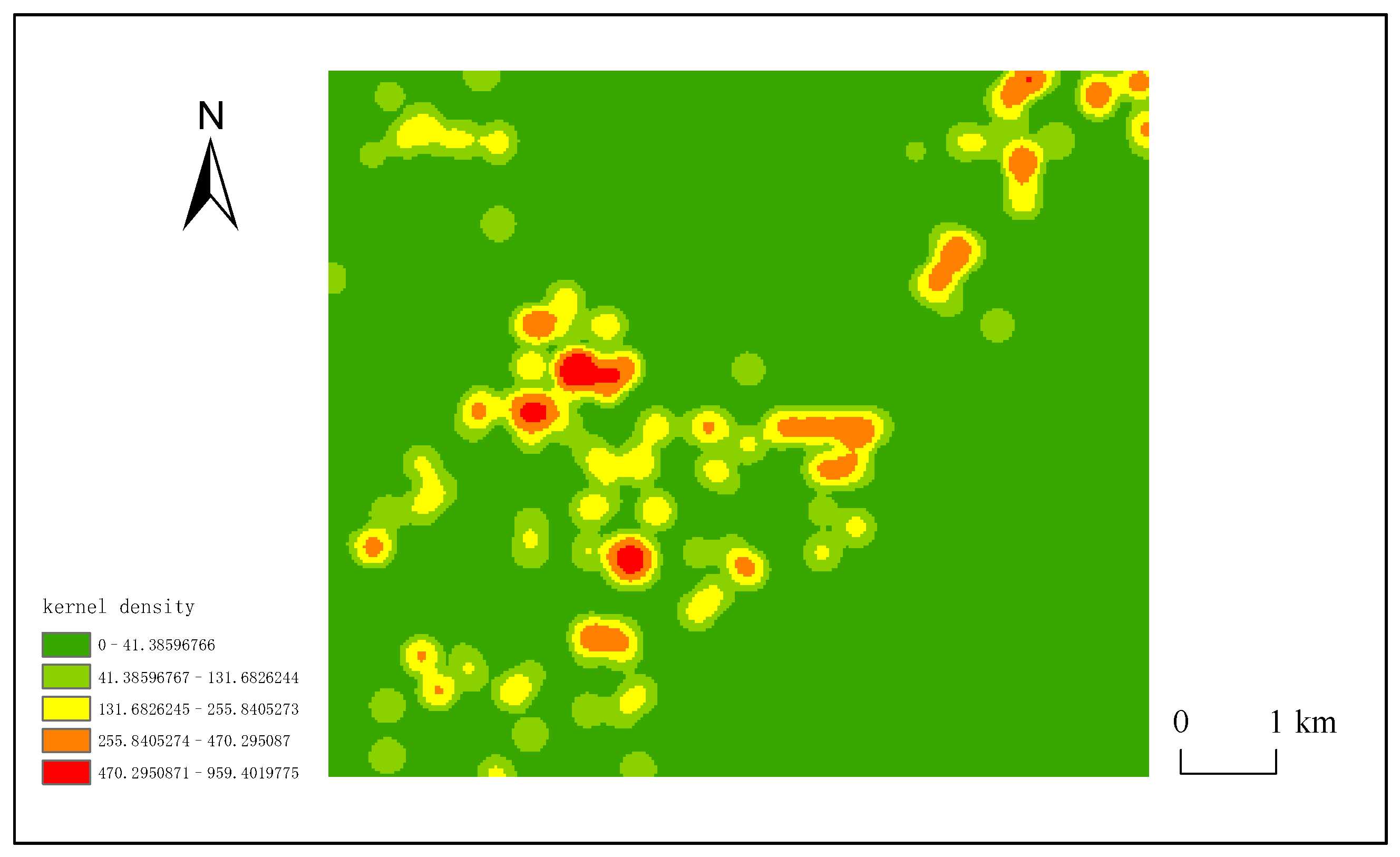
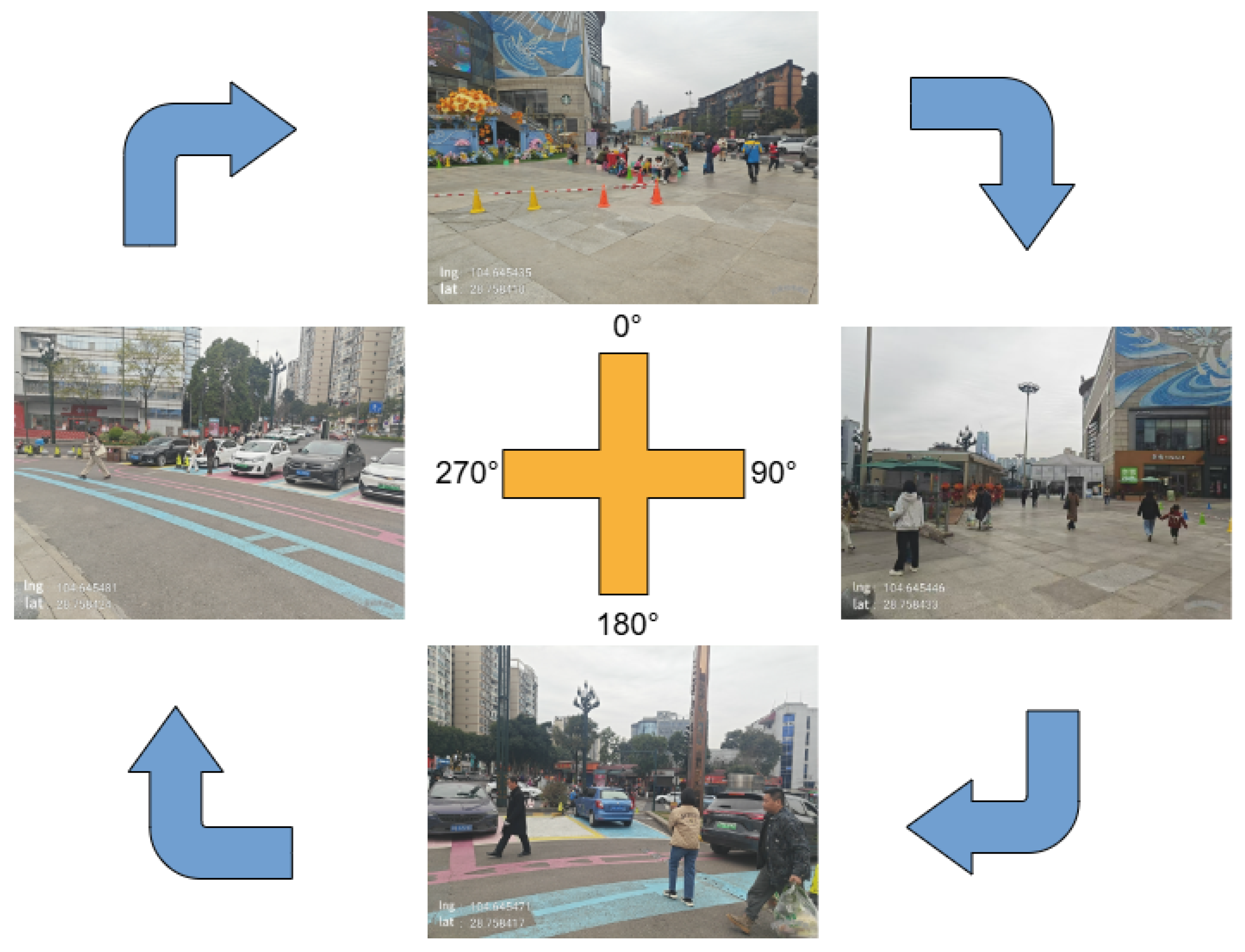
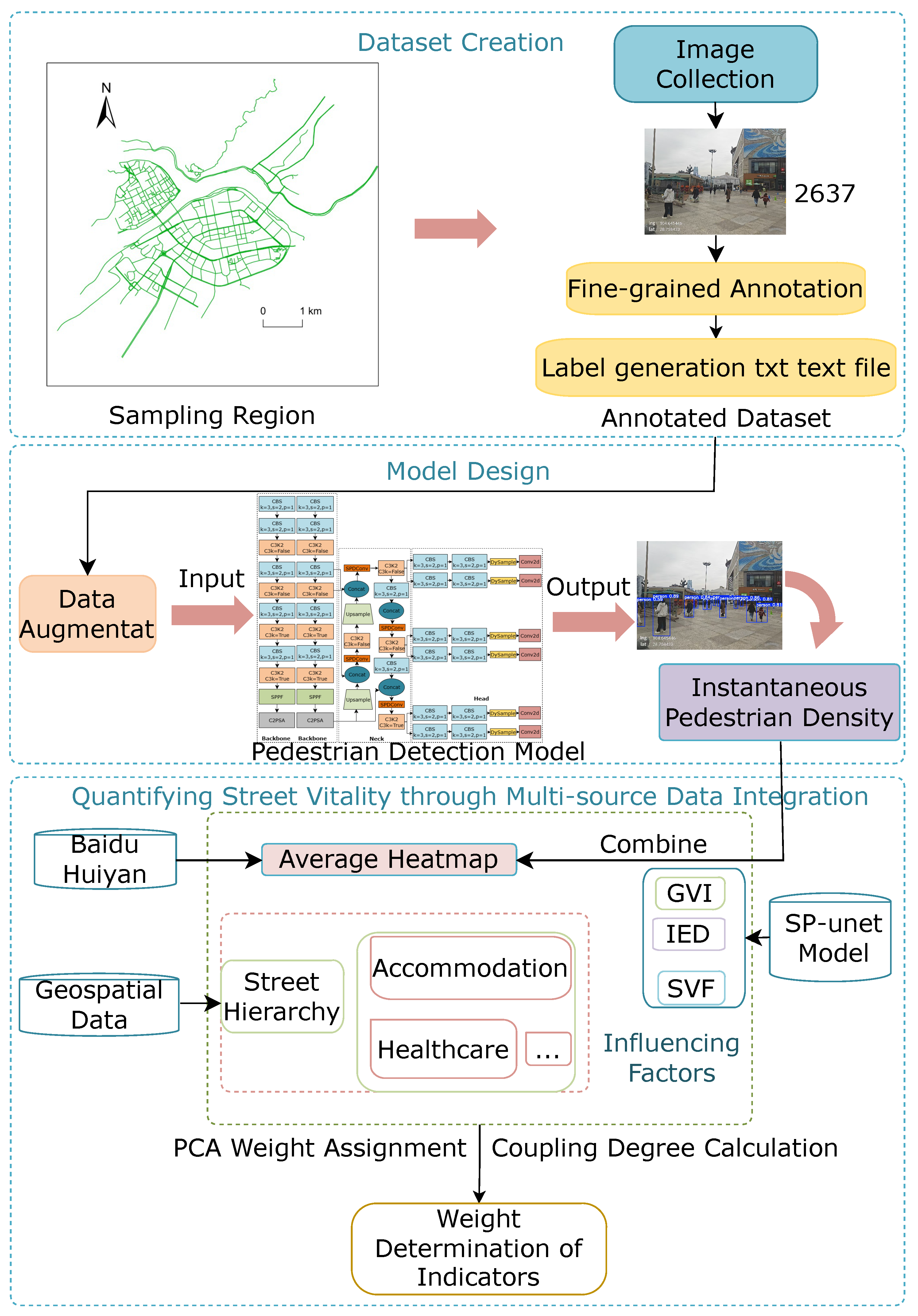
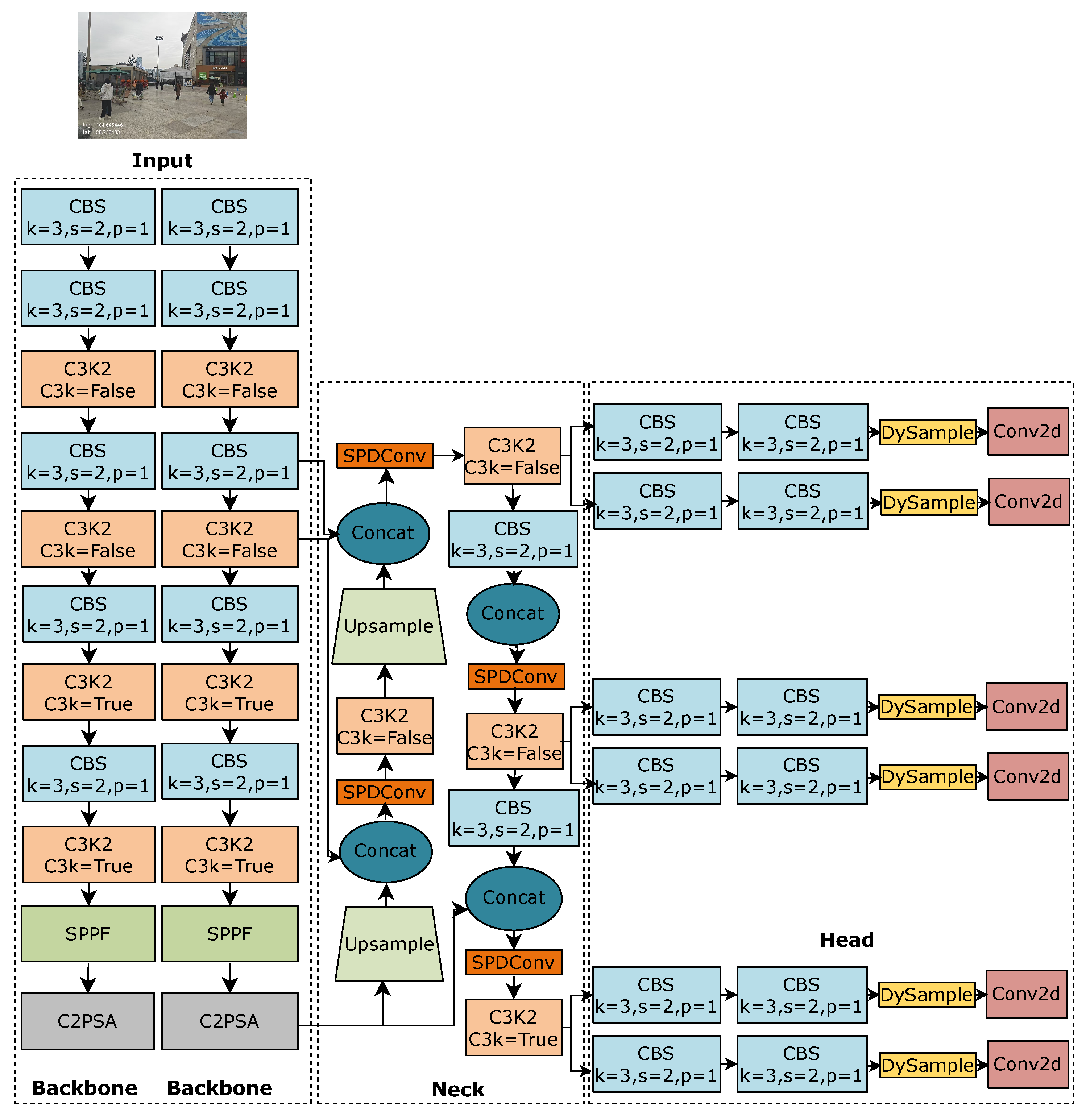
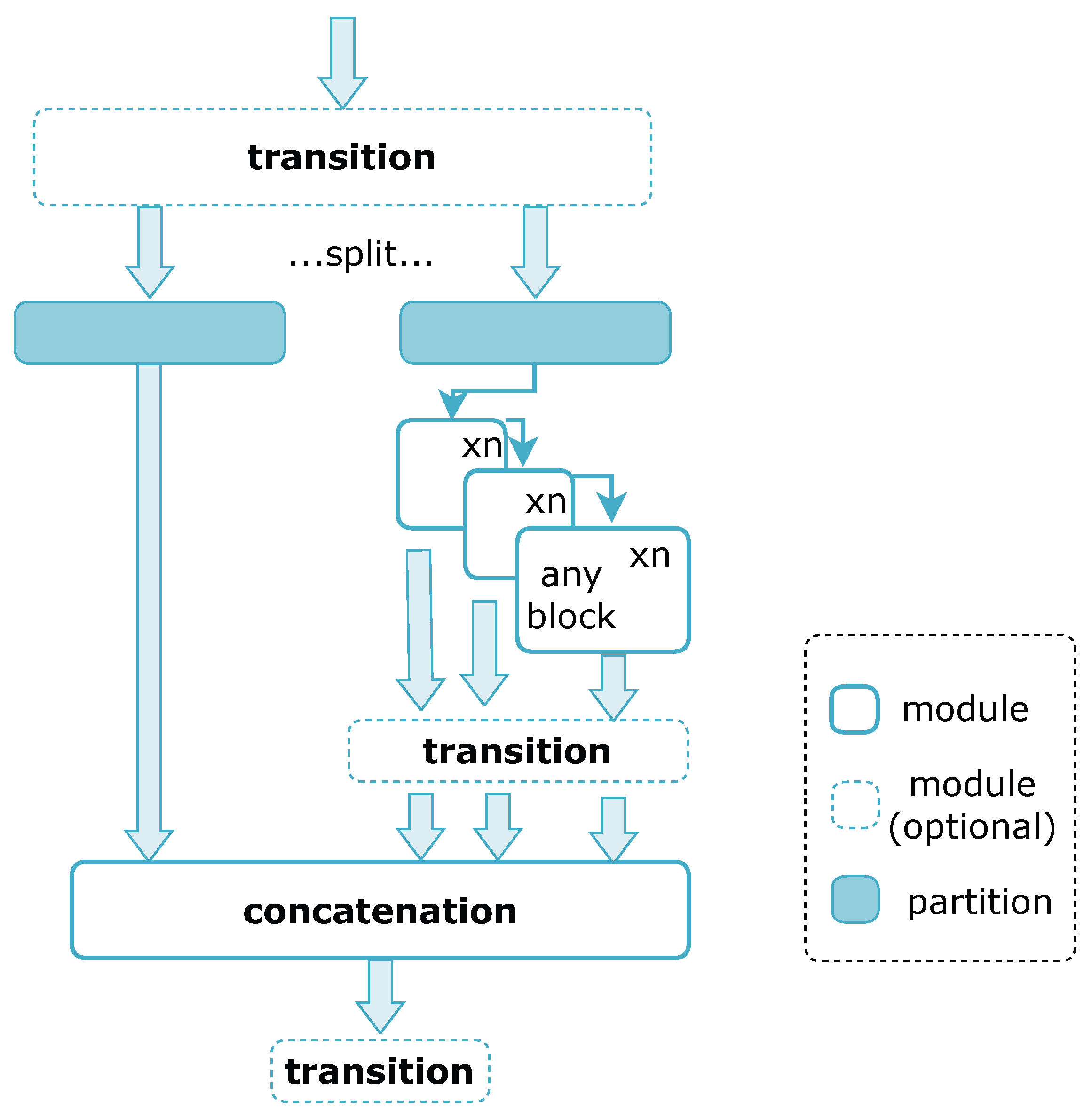
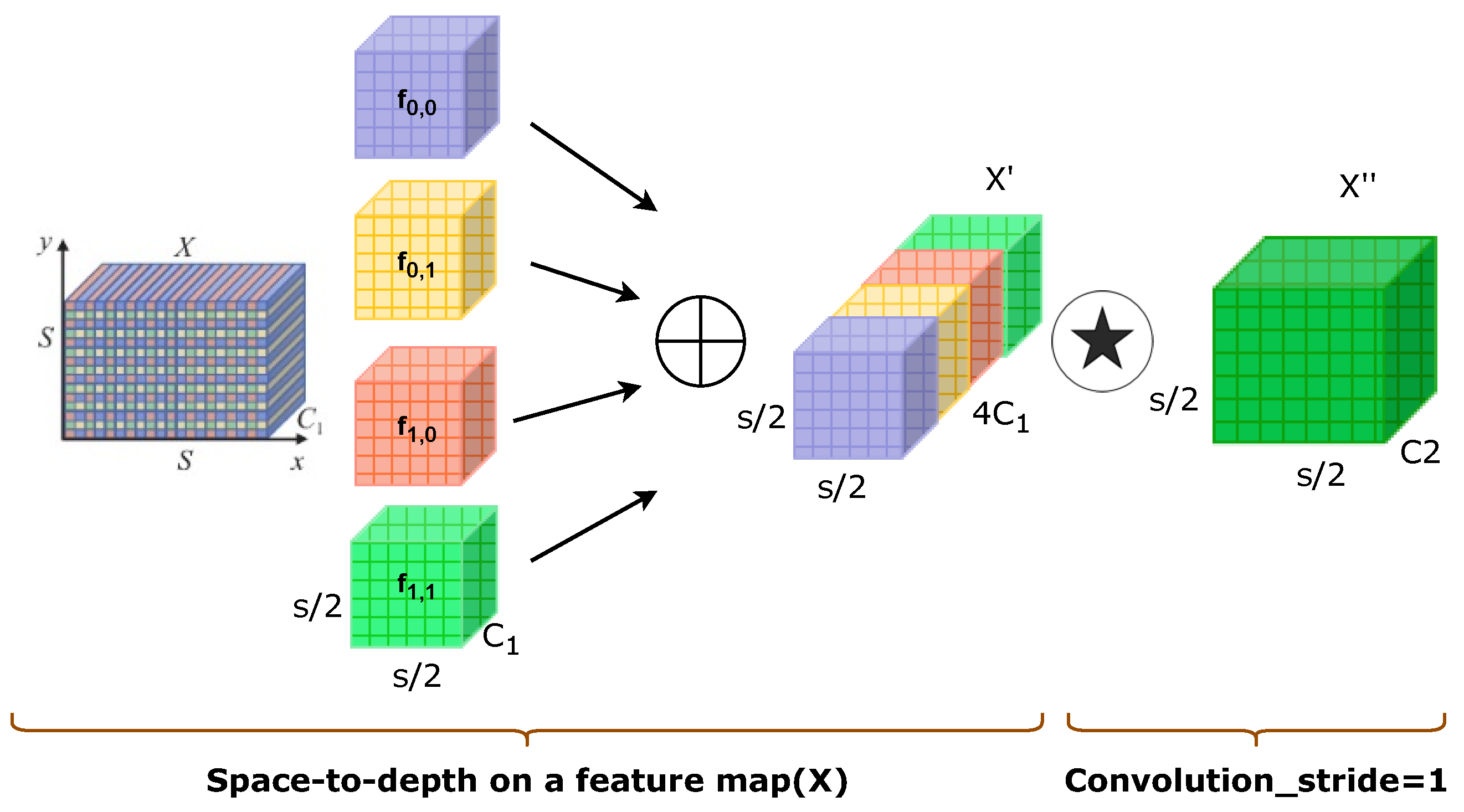
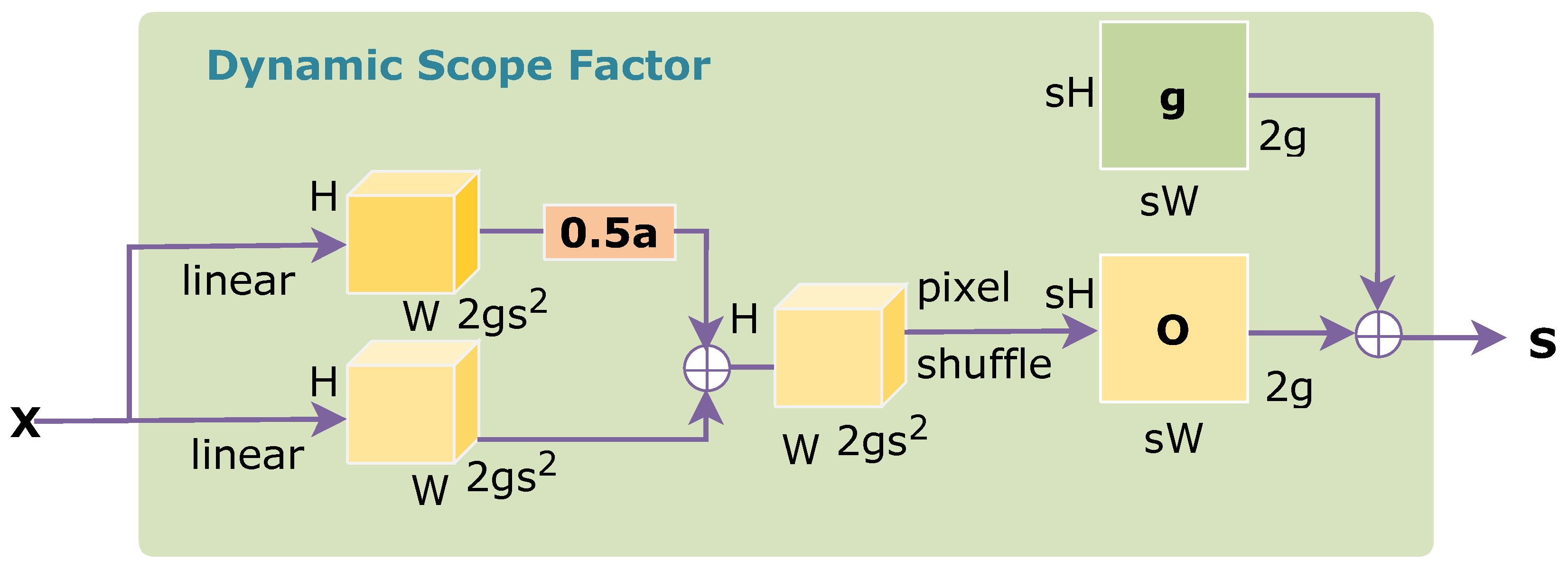
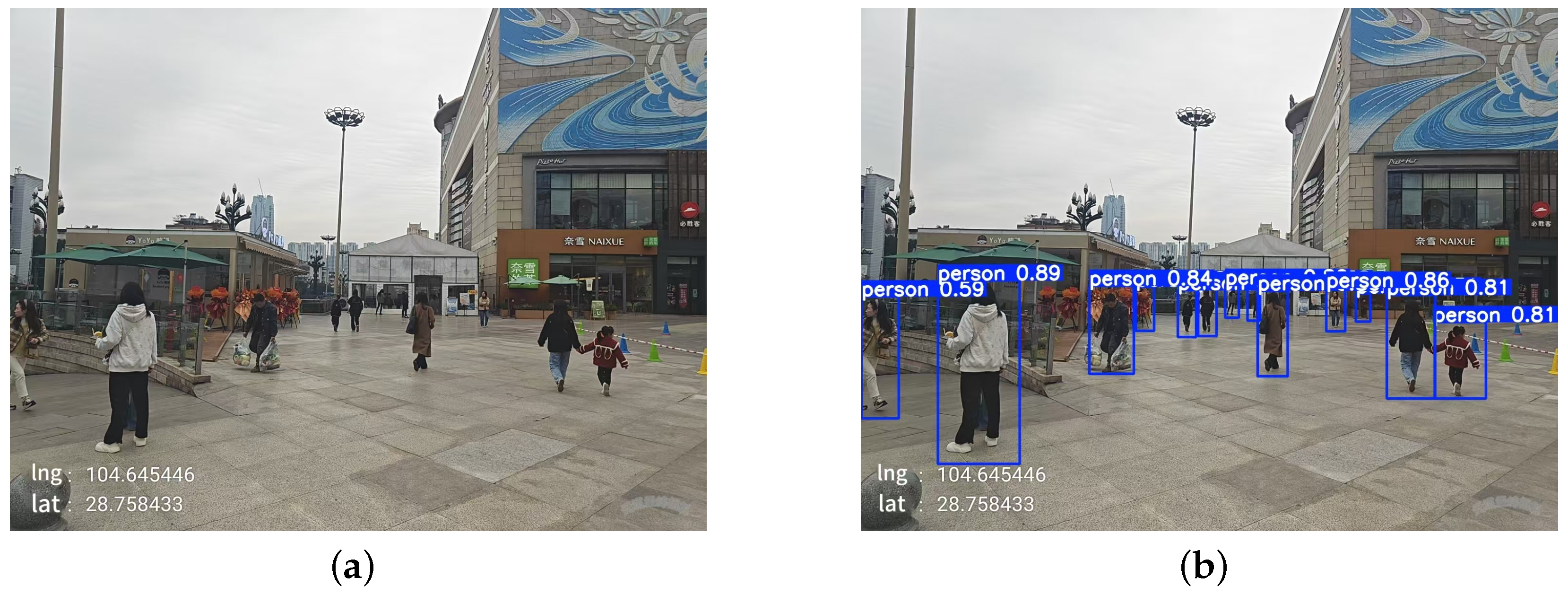

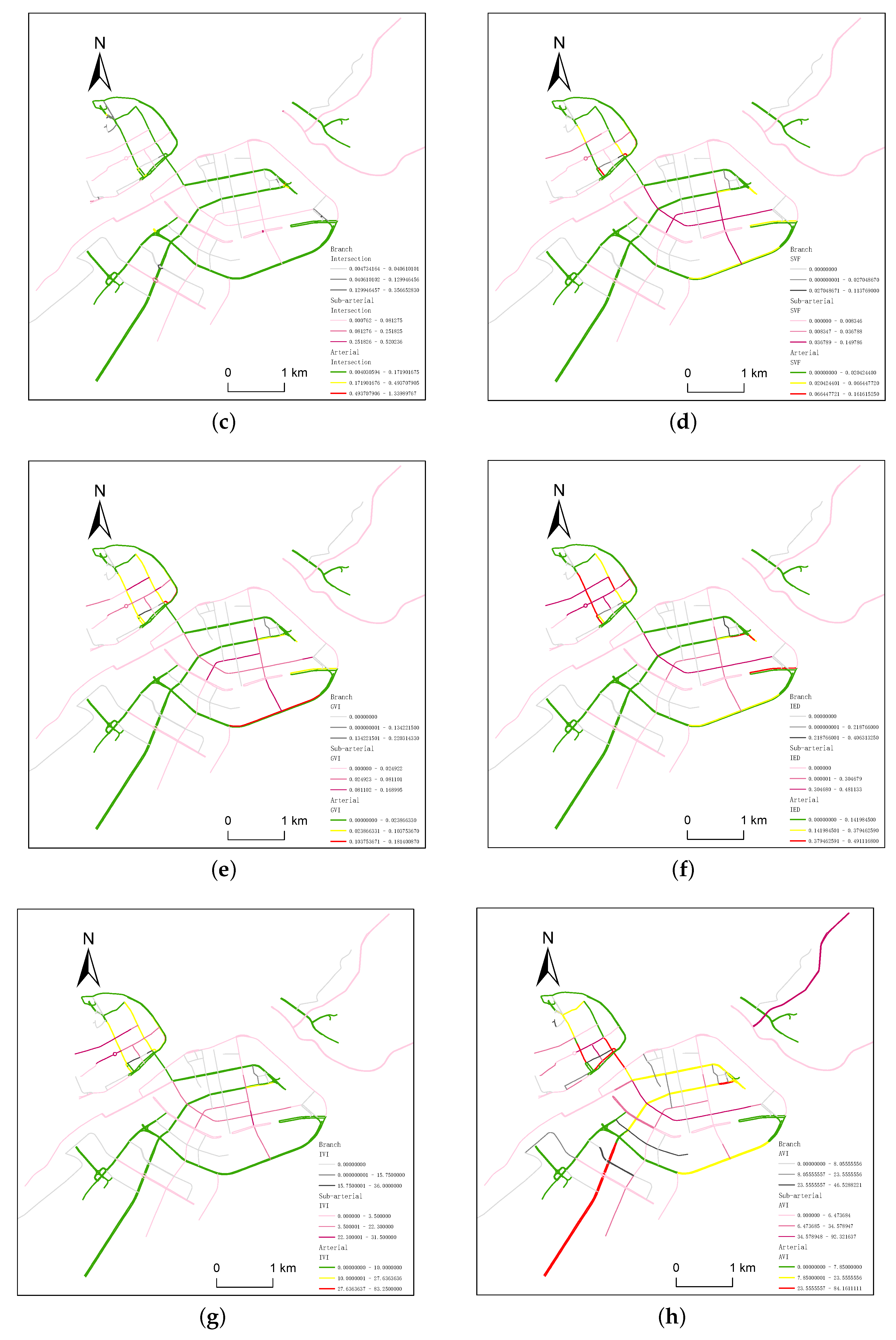
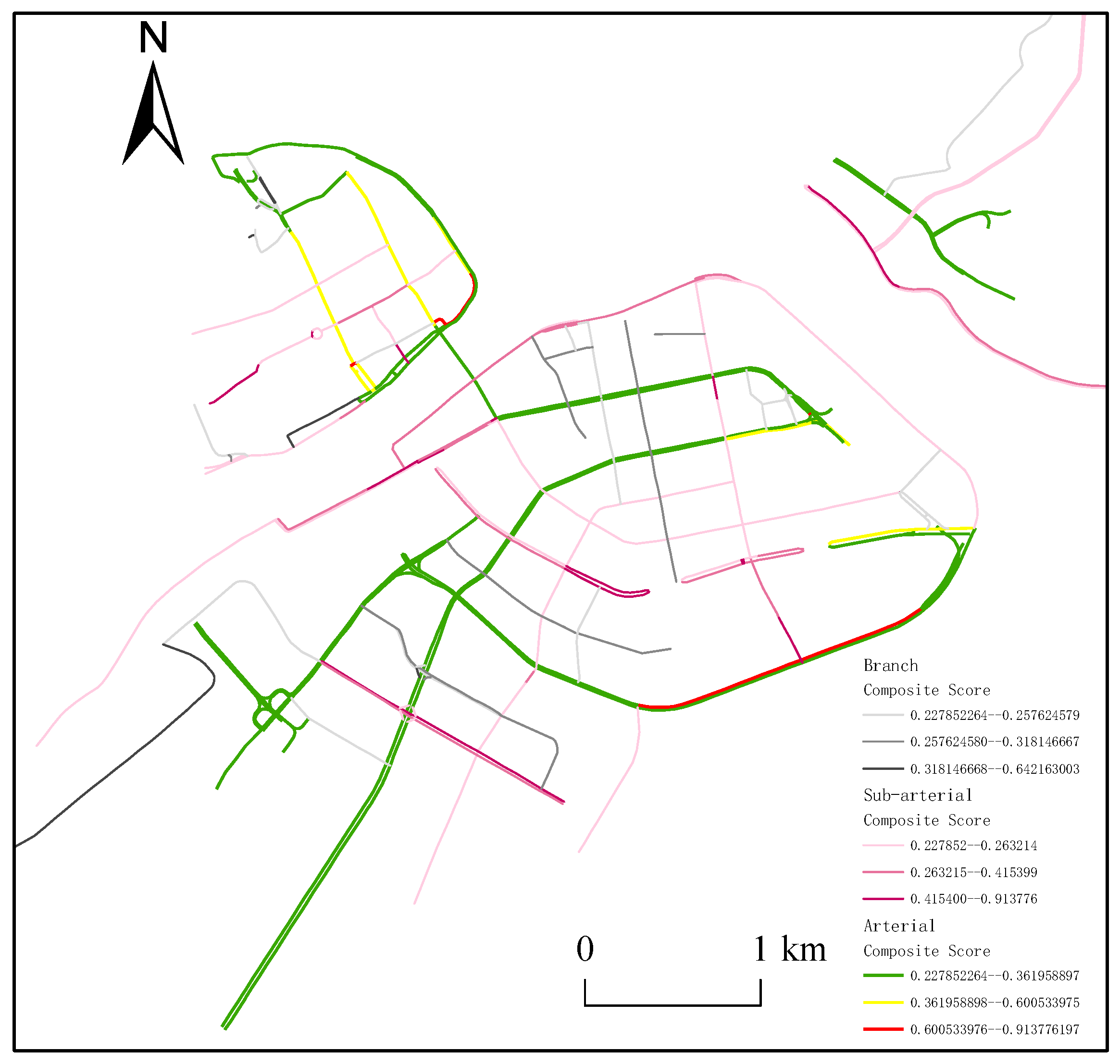
| Category | Bus Stops | Accommodation | Catering | Shopping | Healthcare |
|---|---|---|---|---|---|
| Count | 675 | 1170 | 10,631 | 23,534 | 3547 |
| Indicator Name | Definition / Calculation Formula | Parameter Description |
|---|---|---|
| Road Hierarchy | Assignment based on traffic capacity: arterial road = 3, secondary arterial road = 2, branch road = 1. | – |
| POI Density () | : Total number of catering, accommodation, retail, and healthcare facilities; S: street area. | |
| Intersection Density | Ratio of the number of intersections to the total road length within the study area. | – |
| Bus Stop Density () | : Number of bus stops; : street length. | |
| Green View Index () | : Green vegetation pixel area; : total image area. | |
| Sky View Factor () | : Sky pixel area. | |
| Interface Enclosure Degree () | : Pixel areas of buildings, walls, and fences, respectively. |
| Initial Eigenvalues | Extraction Sums | Rotation Sums | |||||||
|---|---|---|---|---|---|---|---|---|---|
| Comp. | Total | % Var. | Cum. % | Total | % Var. | Cum. % | Total | % Var. | Cum. % |
| 1 | 3.282 | 32.816 | 32.816 | 3.282 | 32.816 | 32.816 | 2.556 | 25.562 | 25.562 |
| 2 | 1.766 | 17.657 | 50.473 | 1.766 | 17.657 | 50.473 | 1.461 | 14.611 | 40.173 |
| 3 | 1.516 | 15.160 | 65.633 | 1.516 | 15.160 | 65.633 | 1.372 | 13.723 | 53.896 |
| 4 | 0.906 | 9.064 | 74.697 | 0.906 | 9.064 | 74.697 | 1.219 | 12.192 | 66.088 |
| 5 | 0.601 | 6.011 | 80.707 | 0.601 | 6.011 | 80.707 | 1.062 | 10.616 | 76.704 |
| 6 | 0.525 | 5.245 | 85.952 | 0.525 | 5.245 | 85.952 | 0.925 | 9.248 | 85.952 |
| 7 | 0.499 | 4.990 | 90.943 | - | - | - | - | - | - |
| 8 | 0.400 | 4.003 | 94.945 | - | - | - | - | - | - |
| 9 | 0.296 | 2.959 | 97.904 | - | - | - | - | - | - |
| 10 | 0.210 | 2.096 | 100.000 | - | - | - | - | - | - |
| Fid | Composite Score |
|---|---|
| 0 | 0.263214 |
| 1 | 0.230591 |
| 2 | 0.234090 |
| 3 | 0.252188 |
| 4 | 0.231865 |
| 5 | 0.294571 |
| Model | Precision (P) | Recall (R) | mAP50 |
|---|---|---|---|
| YOLOv11 | 83.9 | 62.0 | 72.1 |
| YOLOv11 + Two-backbone | 86.9 | 66.9 | 76.2 |
| YOLOv11 + SPDConv | 86.3 | 65.6 | 74.8 |
| YOLOv11 + DySample | 87.3 | 63.8 | 74.4 |
| YOLOv11 + Two-backbone + SPDConv | 88.5 | 67.1 | 76.3 |
| YOLOv11 + Two-backbone + SPDConv + DySample | 90.4 | 67.3 | 77.2 |
| Model | Precision (P) | Recall (R) | mAP50 |
|---|---|---|---|
| YOLOv11 | 83.9 | 62.0 | 72.1 |
| YOLOv8 | 82.8 | 64.0 | 71.7 |
| YOLOv6 | 81.7 | 60.0 | 70.3 |
| YOLO10n | 82.1 | 61.3 | 71.5 |
| YOLOv3-tiny | 81.0 | 59.9 | 66.4 |
Disclaimer/Publisher’s Note: The statements, opinions and data contained in all publications are solely those of the individual author(s) and contributor(s) and not of MDPI and/or the editor(s). MDPI and/or the editor(s) disclaim responsibility for any injury to people or property resulting from any ideas, methods, instructions or products referred to in the content. |
© 2025 by the authors. Licensee MDPI, Basel, Switzerland. This article is an open access article distributed under the terms and conditions of the Creative Commons Attribution (CC BY) license (https://creativecommons.org/licenses/by/4.0/).
Share and Cite
Hua, C.; Lv, W.; Zhang, Y. Spatiotemporal Coupling Analysis of Street Vitality and Built Environment: A Multisource Data-Driven Dynamic Assessment Model. Sustainability 2025, 17, 9517. https://doi.org/10.3390/su17219517
Hua C, Lv W, Zhang Y. Spatiotemporal Coupling Analysis of Street Vitality and Built Environment: A Multisource Data-Driven Dynamic Assessment Model. Sustainability. 2025; 17(21):9517. https://doi.org/10.3390/su17219517
Chicago/Turabian StyleHua, Caijian, Wei Lv, and Yan Zhang. 2025. "Spatiotemporal Coupling Analysis of Street Vitality and Built Environment: A Multisource Data-Driven Dynamic Assessment Model" Sustainability 17, no. 21: 9517. https://doi.org/10.3390/su17219517
APA StyleHua, C., Lv, W., & Zhang, Y. (2025). Spatiotemporal Coupling Analysis of Street Vitality and Built Environment: A Multisource Data-Driven Dynamic Assessment Model. Sustainability, 17(21), 9517. https://doi.org/10.3390/su17219517






